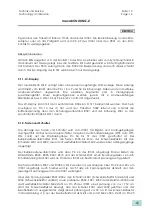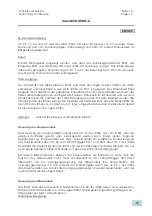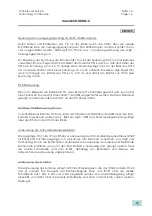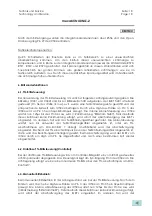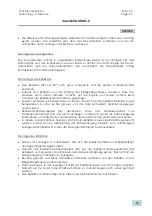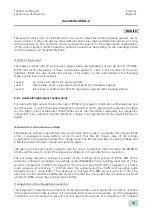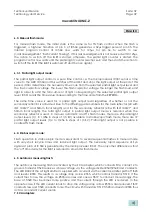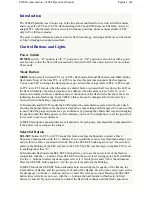
Technik und Service
Seite: 26
Technology and Service
Page: 26
mecablitz 40 MZ-2
ENGLISH
3.1. Principle of operation of the converter circuits:
The mecablitz 40 MZ-2 is supplied with power by two independent converter circuits called, in the
following description, the main converter and the auxiliary converter.
3.1.1. Main converter:
The main converter circuit with the transformer T501 and the transistor Tr503 operates on the
principle of a flux converter and is used primarily to charge the flash capacitors C001 and C002.
When the flashgun is switched on, a high signal appears at pin 43 of the ASIC (IC504). This causes
Tr501 to conduct and to connect the base of the main converter transistor Tr503 to ground via the
control winding 2-5 of T501 and R503. This causes Tr503 to conduct partially. The major part of the
base current of the converter transistor flows through the winding 2-5-4 and through the rectifier
diodes D401 and D402 directly to the flash capacitors, charging these. This current then causes
Tr503 to conduct fully. The full voltage from the power source is now connected via the current-
limiter resistor R501 and the collector-emitter path of Tr503 to the primary winding 8-7 of T501, and
the current through this winding rises rapidly. The voltage induced in the secondary winding 5-4 by
this current causes current to flow from the positive end 4 of the winding via the two rectifier diodes
D401 and D402 to the flash capacitors C001 and C002, which are connected in parallel. When the
saturation induction is reached, the magnetization current of the transformer increases suddenly to
a large value. Since the current in the primary circuit is limited by the resistors in this circuit, the
control current for the converter transistor is reduced proportionally as the magnetization current
increases. Since, at the start of the charging phase, the base current of the converter transistor is
more than enough for full conduction, the load current reduction and the related reduction of the
base current component of this cause the converter transistor to cut off only when the saturation
induction is reached, as the base current of this transistor is then no longer sufficient to provide the
necessary collector current. At this time, the secondary winding 6-5 of the converter transformer
(which now has no load) and capacitor C507 form an oscillating circuit which oscillates for
approximately one half-cycle with the magnetic energy stored in the converter transformer. During
this phase, the voltage in the windings is first reversed: a positive voltage appears at end 2 of the
primary winding and ensures that Tr503 cuts off. After half of the sinusoidal cycle, the voltages
revert to their original polarities. The voltage induced in the secondary winding now exceeds the
voltage on the partially charged flash capacitors and a further charging current flows into these
capacitors. This causes the converter transistor to conduct again, and the above described
sequence of events is repeated.
3.1.2. Main converter voltage monitor:
The main converter circuit is equipped with a monitoring circuit and a protection circuit. These
ensure that the flash capacitor voltage matches the operating conditions and that the capacitors
are never overcharged.
A voltage proportional to the flash capacitor voltage is supplied via the voltage divider R407/R324
to pin 26 of the microprocessor. This analog measuring input of the microprocessor ensures that the
main converter is switched on and off in accordance with its operating state and requirements
with the aid of the "DC-Main ON/OFF" stage of the ASIC, which is in turn controlled via the data bus
of the microprocessor.

